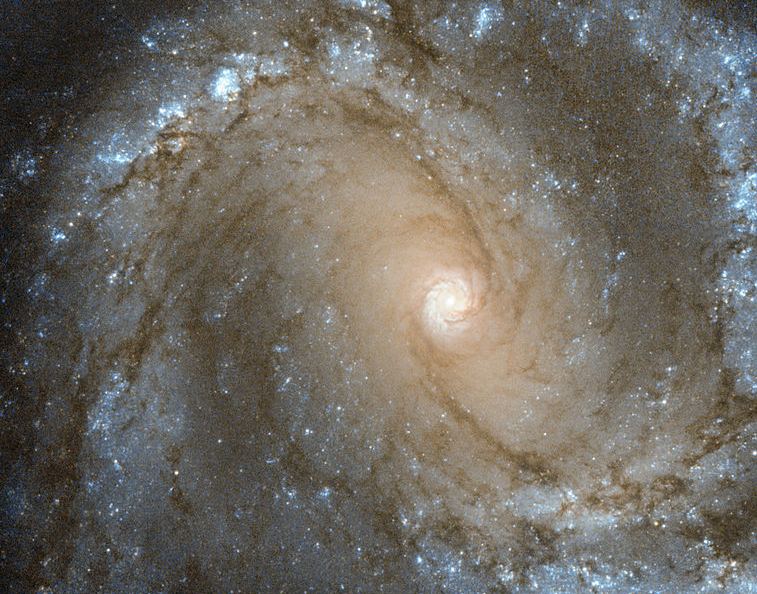Welcome back to Messier Monday! Today, we continue in our tribute to our dear friend, Tammy Plotner, by looking at the barred spiral galaxy known as Messier 61.
In the 18th century, while searching the night sky for comets, French astronomer Charles Messier kept noting the presence of fixed, diffuse objects he initially mistook for comets. In time, he would come to compile a list of approximately 100 of these objects, hoping to prevent other astronomers from making the same mistake. This list – known as the
Messier Catalog
– would go on to become one of the most influential catalogs of Deep Sky Objects.
One of these objects is the intermediate barred spiral galaxy known as Messier 61. As one of the larger galaxies located in the Virgo Cluster, this galaxy is roughly 52.5 million light years from Earth and contains some spectacular supernovae. It also has an
Active Galactic Nucleus
(AGN), meaning it has a
Supermassive Black Hole
(SMBH) at its center, and shows evidence of considerable star formation.
What You Are Looking At:
Spanning about 100,000 light years across and about the same size as our own Milky Way Galaxy, this grand old spiral is one of the largest in the Virgo Cluster... and one of the most active in terms of starbursts and supernovae. According to Luis Colina (et al) indicated in a
1997 study
:
[caption id="attachment_137974" align="aligncenter" width="580"]
The Virgo Cluster Galaxies. Credit & Copyright: Rogelio Bernal Andreo
[/caption]
Another fascinating aspect is Colina's team has also identified a Super Star Cluster (SSC) withing Messier 61 as well. As Colina indicated in a
2002 study
:
Of course, studies don't just stop there. As D. Tschoke (et al) indicated in a
2000 study
:
[caption id="attachment_137973" align="aligncenter" width="580"]
Hubble picture is the sharpest ever image of the core of spiral galaxy Messier 61. Taken using the High Resolution Channel of Hubble's Advanced Camera for Surveys. Credit: ESA/NASA/HST
[/caption]
When it comes right down to it, it's all about that star-forming ring. Said Eva Schinnerer (eta al) in a
2002 study
:
How will today's technologies continue to study the magnificent M61? Just take a look at what MOS can do! The very efficient multi-object-slit observing technique with the multi-mode instrument FORS1 has been demonstrated on the Virgo cluster galaxy NGC 4303 . Nineteen moveable slits at the instrument focal plane are positioned so that the faint light from several H II regions in this galaxy can pass into the spectrograph, while the much stronger "background" light (from the nearby areas in the galaxy and, to a large extent, from the Earth''s upper atmosphere) is blocked by the mask.
History of Observation:
M61 was discovered by Barnabus Oriani on May 5, 1779 when following the comet of that year. Said he, "Very pale and looking exactly like the comet." As for our hero, Messier, he had also seen it on the same night - but thought it
was
the comet! Because Charles Messier was a good astronomer, he returned nightly to observe movement and it only took him a few days to realize his mistake and to admit it in his own notes:
[caption id="attachment_137972" align="aligncenter" width="580"]
Supernova SN2008in in the spiral galaxy Messier 61. Credit: Hewholooks/ Wikipedia Commons
[/caption]
Sir William and Sir John Herschel would also later return to M61 to assign it their own catalog numbers, both resolving certain portions of this wonderful galaxy - but neither truly beginning to understand what they were seeing. That took Admiral Smyth, who recorded in his notes:
Locating Messier 61:
Locating Messier 61 is the Virgo Galaxy fields is relatively easily because it is so large and bright compared to any others in the area. Begin your hunt by identifying Beta and Delta Virginis. Between this pair you will see finderscope or binocular visible stars 17 and 16 Virginis. You destination is between this pair of stars. While M61 is binocular possible, it would require astronomical binoculars of approximately 80mm aperture and dark skies - although with excellent sky conditions the nucleus can be glimpsed with apertures as small as 60mm.
[caption id="attachment_137971" align="aligncenter" width="580"]
This star chart for M61 represents the view from mid-northern latitudes for the given month and time. Credits: NASA/Stellarium
[/caption]
In a small aperture telescope, M61 will appear as a very faint oval with a bright central region. As size increases, so do details and resolution. At 6-8" in size, the nucleus becomes very clear and beginnings of spiral arms start to resolve. In the 10-12" range, spiral structure becomes clear and some mottling texture becomes clear.
Enjoy your observations!
And here are the quick facts on Messier 61 to help you get started:
Object Name: Messier 61 Alternative Designations: M61, NGC 4303 Object Type: Type SABbc Spiral Galaxy Constellation: Virgo Right Ascension: 12 : 21.9 (h:m) Declination: +04 : 28 (deg:m) Distance: 60000 (kly) Visual Brightness: 9.7 (mag) Apparent Dimension: 6x5.5 (arc min)
We have written many interesting articles about Messier Objects here at Universe Today. Here's Tammy Plotner's
Introduction to the Messier Objects
,
M1 – The Crab Nebula
, and David Dickison's articles on the
2013
and
2014
Messier Marathons.
Be to sure to check out our complete
Messier Catalog
. And for more information, check out the
SEDS Messier Database
.
Sources:
- Messier Objects - Messier 61
- *NASA - Messier 61*
- *SEDS - Messier 61*
- *Wikipedia - Messier 61*
 Universe Today
Universe Today
